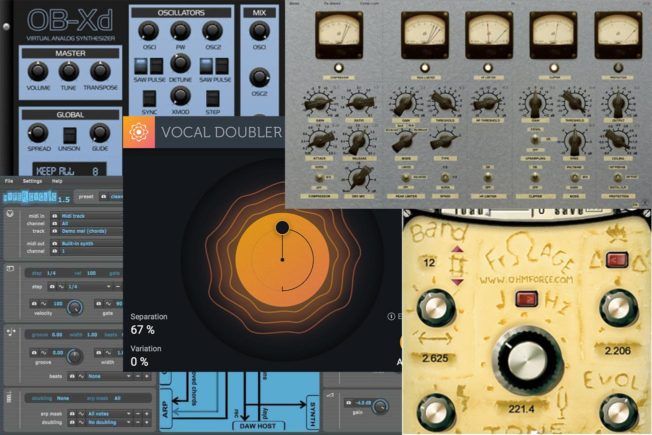This free VST plugins roundup features a vocal doubler, a mastering limiter, an Oberheim OB-X synth emulation, a multiband filter, and an arpeggiator.

Free VST Plugins
Each month we search the web for some of the music industry’s most essential freeware instrument and effect plugins. This list of free VST plugin downloads offers five modern tools for your arsenal. No need to spend a dime or waste time trawling the internet.
1. iZotope | Vocal Doubler
iZotope Vocal Doubler is a free VST plugin designed to enhance your vocal with a natural doubling effect. Insert Vocal Doubler on your vocal track to add richness, depth, and a touch of space to make it stand out in the mix.
2. Vladg Sound | Limiter no. 6
Limiter no. 6 is a free mastering limiter plugin. Its modular design offers five modules: RMS compressor, peak limiter, high-frequency limiter, clipper, and true peak limiter. It also features M/S and multiband modes. Moreover, Limiter no. 6 provides brickwall and soft limiting with different timing settings.
3. discoDSP | OB-Xd
OB-Xd is free synth plugin based on the iconic Oberheim OB-X. It attempts to recreate the original OB-X’s rich sound and behavior. The plugin version also adds modern features that are not available on the original hardware. It also sports a set of onboard audio effects.
4. Ohm Force | Frohmage
Frohmage is a free multiband resonant filter plugin. This powerful filter adds character. Use it to emphasize or attenuate frequencies, brighten, warm, colorize or dirty any source lacking character. Moreover, you can process up to 15 frequency bands. It also sports a built-in distortion effect with two routing schemes and delay stages on each band for unique phasing-like effects.
5. Mucoder | Hypercyclic
Hypercyclic is a free LFO-driven, midi-mangling arpeggiator plugin. Generate midi patterns that are simple or complex. Use the two tempo-synced LFOs to also modulate various parameters. You can create interesting rhythmic effects, chord variations, and glitchy stuttering effects. It also features a groove function to add rhythmic variation. Moreover, Hypercyclic features a built-in synth for testing purposes.

Turn your passion for music into a Profession: Learn more about our Music School Programs!
MORE ARTICLES FROM THE ICON BLOG

FIND YOUR SOUND, HONE YOUR CRAFT:
Are you ready to turn music into a career? ICON prepares students to become music producers, composers, performers, recording artists, professional DJs, and entrepreneurs in the entertainment industry. Click below to get information about our award-winning programs:

